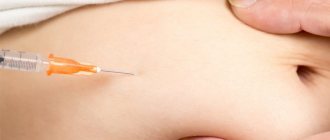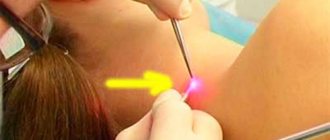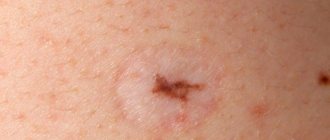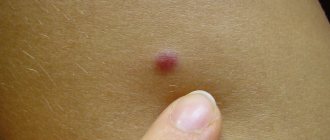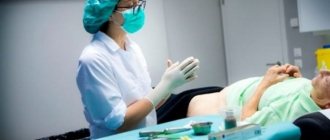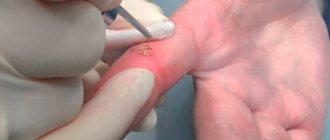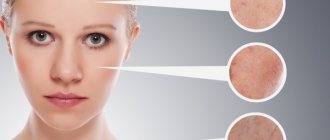Surgical removal of lipoma
It would be more correct to call this procedure “traditional”, because any removal of tumors is a surgical procedure. Before the procedure, you will need to undergo an examination, the results of which will be needed by the surgeon. Most often, it will be enough to take a general blood and urine test and do fluorography. Depending on the general health of the patient, additional examinations may be required: blood sugar test, electrocardiogram, etc. - as prescribed by a specialist.
The operation itself on a small tumor is performed under local anesthesia. The surgical field is injected with anesthetic, disinfected, an incision is made through which the tumor is removed along with the capsule, and sutures are placed. The whole procedure takes no more than 15 minutes. The contents of the capsule are sent for histological examination, which is necessary to exclude a malignant process.[box#2]
If the operation is performed on open areas of the body - face, neck, arms - the surgeon may apply a cosmetic suture with an absorbable thread. In this case, there is no need to remove the stitches. Regular sutures are removed after 10-12 days, by which time the histology result is usually ready. If you are not prone to keloid scars, the scar will appear as a small light stripe that will become invisible over time.
Features of seam formation and care
The relevance of postoperative sutures is due to the need to connect the cut skin. If the wound is not sutured, its healing will be problematic, with constant bleeding. After removing the wen, sutures are applied depending on the volume of the operated area. If the affected area is wide enough, drainage is inserted into the resulting cavity. It ensures the pumping out of fluid that will occur during the healing period.
Caring for the affected area involves the following steps:
- Regular change of dressing material. A dirty dressing can harbor dangerous bacteria. Against this background, swelling, discomfort, inflammation and the formation of a purulent mass may appear.
- Wash your hands thoroughly before touching the affected area.
- Treat the edges of the incision with the required amount of antiseptics.
- Try to avoid direct contact of the wound with water, towels, and linen.
- Use only medications and treatments prescribed by your doctor.
- Why do papules appear after Restylane injections?
- Causes of wen in the mouth
- What can happen if you don't remove a wart?
Proper care is a guarantee of successful healing of the skin. If you follow the recommendations and observe hygiene procedures, the risk of complications will be prevented.
READ ALSO: Cleansing toner for face; Clean skin; against blackheads and oily shine with absorbent Perlite Garnier 2026252 in the online store
Progress of the operation: how the lipoma is removed
Many of our patients laugh: they say, well, what kind of operation is this, just to remove the wen... However, despite all the “uncomplicatedness”, lipoma removal is a surgical intervention, and therefore you need to take it seriously and follow the surgeon’s recommendations.
Anesthesia is not always used for such an operation, especially when it comes to using a laser. The surgeon makes a small incision (with a scalpel or laser), and through this incision the “culprit of the operation” is carefully removed. As mentioned above, the lipoma must be removed completely - the capsule itself and all its fatty contents.
In addition, even with such a simple intervention, it is necessary to ensure sterility (a laser helps a lot here). There is a separate question about the invisibility of a postoperative scar: you must agree that a small but noticeable scar will spoil the face or neck. The laser makes it possible to make the incision very thin and the scar invisible. Therefore, our surgeons very widely practice the use of a laser knife - almost always when there are no contraindications.
After removing the lipoma, a sterile bandage is applied to the intervention area. As a rule, the surgeon’s control over the healing process of the incision is not required, with the exception of complicated clinical cases when a lipoma with inflammation or suppuration was removed.
The cost of removing a lipoma, like other tumors, will pleasantly surprise you. You can get rid of an unsightly wen as soon as possible by calling us right now.
Radio wave method for removing wen
In fact, removing a tumor using the radio wave method is the same surgical operation, only the tissue is cut not with a metal scalpel, but with a “radio knife”, which, while cutting the skin, simultaneously seals (coagulates) the capillaries. Thus, the cut is bloodless. Despite all the advantages of radio wave surgery, there are contraindications to its use:
- the diameter of the neoplasm is over 6 cm;
- acute infectious diseases;
- elevated temperature;
- diabetes mellitus, epilepsy;
- the presence of metal implants or a pacemaker.
Atheromas on the scalp are most susceptible to trauma followed by inflammation. In this case, the radioknife is most effective. The operation is performed under local anesthesia in the same way as with a regular scalpel. If the size of the neoplasm does not exceed one centimeter, stitches do not need to be applied; in other cases, the wound is sutured. The advantage of this method is painless postoperative recovery, which is achieved through nerve coagulation.
How is basal cell carcinoma removed by laser and are there any contraindications?
Why has laser technology become popular?
Laser treatment of basal cell carcinoma has many advantages, the main ones of which I would like to note:
- rehabilitation does not take much time;
- the aesthetics of the skin is preserved;
- the procedure is painless;
- relapses are excluded;
- sterility is ensured, thereby eliminating complications;
- the procedure is contactless.
The laser technique is especially effective in the first stage of basal cell carcinoma. If the tumor is minimal in size, then no traces remain. Using a laser, you can reach hard-to-reach places without damaging healthy tissue.
Laser removal does not require any preparatory procedures. The operation is performed under local anesthesia, so it does not cause discomfort. More information about how this treatment of basal cell carcinoma occurs is described below. And now I suggest you familiarize yourself with the prices for the procedure.
Cost of laser treatment
The cost of modern cancer therapy may seem high. On average, the price for removing a tumor up to 1 cm² is equal to 1000-3000 rubles. (depending on the clinic).
People who have undergone treatment leave mostly positive reviews, in which they claim that the price is fully justified by the quality and effectiveness.
Contraindications: in what cases is laser treatment not performed?
Unfortunately, not every patient is eligible for a highly effective treatment method for basal cell carcinoma. The main contraindications include:
- acute infectious diseases;
- diabetes;
- skin damage;
- vascular and heart diseases;
- certain chronic diseases;
- individual contraindications (hypersensitivity, for example);
- endocrine abnormalities;
- pregnancy.
If the patient has no contraindications, then he can safely undergo the procedure. Are you interested in how laser treatment is performed?
Laser removal technique for basal tumor
To ensure there are no contraindications, the patient must undergo medical examination. inspection according to the standard scheme. In addition, he needs consultation with a dermatologist and oncologist.
The specialist will carefully examine the history, stage and other features of epidermal oncology, and then decide whether the patient needs laser therapy.
The operation is carried out as follows:
- The surgical site is thoroughly disinfected using antiseptic drugs.
- Local anesthesia is administered.
- The surgeon acts with a laser beam directly on the tumor, while protecting the surrounding tissue as much as possible.
Rehabilitation period
Laser surgery does not require a long rehabilitation period. After laser removal, a small, neat wound remains on the epidermis.
If you care for it correctly, then no negative complications can arise. If you neglect care, there may be consequences:
- infection - the addition of a bacterial infection;
- slowing down the wound healing process;
- darkening of the area around the wound;
- the appearance of a scar or scar after healing.
To prevent the above complications, you must follow your doctor's recommendations regarding skin care in the postoperative period.
Caring for the wound is actually quite simple. It must be treated with disinfectants and kept clean.
How to treat a wound, you ask? This should be done carefully, using a cotton pad or cotton swab, around the perimeter of the wound. The following drugs are used for treatment:
- brilliant green solution;
- iodine solution;
- potassium permanganate;
- hydrogen peroxide.
All these drugs can be bought at any pharmacy for a low price. They should be used carefully and in moderation, since some of them, for example, iodine, can cause a chemical burn.
A natural crust gradually forms on the wound, which should not be touched. After peeling off the crust, a wound-healing and anti-scar ointment, for example, hydrocortisone, is used.
The duration of laser treatment for basal cell carcinoma lasts from two weeks to a month (from surgery to complete recovery).
This depends on the individual characteristics of the body and the regenerative function of the skin (for each of us, regeneration occurs differently).
The prognosis after laser excision is predominantly positive: almost 100% of patients treated at an early stage never experience basal cell carcinoma again.
Additional recommendations during the rehabilitation period
During the rehabilitation period, it is necessary to check whether the wound is bleeding. During normal healing, the wound should not bleed, but a clear sticky liquid may ooze from it, from which a crust will subsequently form.
To speed up the wound healing process, it is necessary to increase the regenerative abilities of the skin. To do this, follow the recommendations:
- take vitamins A and E;
- use topical preparations based on hyaluronic acid;
- Take care of your skin daily and thoroughly;
- Beware of direct sunlight;
- Protect your skin from injury and burns.
A patient who has had a basal cell carcinoma removed by laser should undergo regular oncological examinations. In the first year after surgery, examinations are carried out at least once every six months.
The doctor carefully examines the place where the tumor was previously located, and also listens to the patient’s complaints, if any. The examination is carried out to prevent relapses.
Now you know what it is - laser treatment for basal skin cancer. I hope the article answered all the questions. You can share what you read on social networks, and if you subscribe to site updates, you won’t miss new articles. All the best!
Author of the article: Anna Derbeneva (dermatologist)
Publication date: 07-10-2016
- 5
- 4
- 3
- 2
- 1
More articles on the topic
How to recognize basal cell skin cancer?
What are the signs of skin cancer and how can you diagnose the disease yourself?
Wen on the face - causes and treatment
The most common types of wen:
- milia are small in size, filled with a white composition;
- lipomas are a mobile type of neoplasm, constantly increasing in size.
The reasons for their occurrence and the method of removal depend on the type of tumor. Wen can appear on any part of the body, and the face is no exception.
The reasons for their appearance include:
- genetic factor
- nutritional imbalance, lack of minerals, vitamins and other nutrients,
- disease of the urinary and endocrine system.
You can get rid of “white wen” at home by squeezing them out, since they have no way out. First you need to make a puncture with a clean, sterile needle and squeeze it out. The extrusion site is wiped with an antiseptic swab both before and after the procedure.
READ ALSO: Treatment of facial acne in teenagers - boys, girls
If there are a large number of “white wen”, then it is advisable to get rid of them in a cosmetology salon using: laser therapy or chemical peeling.
You can get rid of lipomas by surgical excision. Removing them at home can lead to either overgrowth or tissue damage. During the removal procedure, a laser is used to cauterize the tumor. Tissue healing occurs within 2 weeks.
White wen - causes
White wen on the face is called milia. They can appear on the skin either singly or in several dozen at once, thereby forming a rash. They are not harmful to health and are considered to be a cosmetic defect. Lipomas of this type are absolutely painless, but can cover large areas of facial skin.
Their favorite place is the chin and cheeks; they rarely appear on the eyelids. The appearance of “white wen” on the face is accompanied by improper skin care. Most often appear on combination or oily skin types. Excess fat and lipid metabolism disorders are the main reason for their appearance.
Subcutaneous
Subcutaneous wen should be called lipomas. They are a capsule of fat that, when pressed, becomes mobile. Subcutaneous neoplasms are most often painful, since during the growth process they can affect nerve tissue.
Their origin is similar to the reasons for the appearance of milia. However, in some cases they occur due to diseases such as diabetes mellitus, dysfunction of the endocrine system, or genetic disposition.
Wen on the face of a newborn
The causes of a neoplasm in a child may be heredity or blockage of the sebaceous glands. They can appear on the cheeks, forehead, eyelids, lips, and on the body itself.
There is no point in getting rid of them at home. It is necessary to consult an experienced doctor and surgeon. Particular attention should be paid if the wen is inflamed. Because this may be a neoplasm of a different nature.
Wen on the nose, lips, and cheeks are not particularly dangerous. They arise in most cases due to underdevelopment of the sebaceous glands, and, as a rule, disappear over time on their own.
If the tumor is located in the neck area, especially with suppuration, you should consult a doctor as soon as possible. Since as the lipoma grows, the vessels may be compressed, which will lead to poor circulation.
Causes of lipomas on the head, neck, back
There are 3 versions of the reasons for the appearance of a benign tumor in the subcutaneous fat.
The first is confirmed by scientific research: fat cells begin to grow rapidly, this process proceeds non-stop, so a person can periodically discover more and more new formations in the form of “peas”. The second version is voiced by doctors: lipoma is a consequence of blockage of the sebaceous glands, possibly influenced by a hereditary factor and health problems (for example, due to hormonal disorders).
Lipoma in the armpit
The third version is voiced by the people ; it has no official confirmation, but some doctors believe that it has a right to exist. We are talking about impaired functionality of the liver, gall bladder and the excessive presence of waste/toxins in the body.
Lipomas can be single or multiple formations. In the latter case, doctors diagnose lymphomatosis. Any type of benign tumor of the subcutaneous fat layer does not pose a danger to human health and life, but if it is too large, it spoils the appearance. Naturally, the question arises about solving the problem - lipoma can only be treated by removal.
We recommend reading the article about methods for removing atheroma. From it you will learn about the locations of atheroma on the body and methods for removing atheroma. And here is more information about removing Bish’s lumps.
Laser lipoma removal
Unfortunately, laser removal of tumors has its own contraindications. This method is not used during pregnancy and breastfeeding, diabetes, the presence of infectious skin disorders in the area of intended exposure, or immunodeficiency states. Deep-lying, large or branched neoplasms, as well as those whose structure includes vessels and nerves, are not removed using a laser.
In general, the operation is similar to the previous methods. The surgical field is anesthetized, the skin over the tumor is cut with a laser beam, and small vessels are cauterized at the same time. Then the capsule with its contents is removed using a clamp and cut off with a laser. At the end, the wound is sutured and a sterile bandage is applied. The entire procedure takes 15-40 minutes, and during the rehabilitation period you only need to follow the rules of asepsis to avoid inflammation of the wound.
Possible methods of dealing with scars
A scar after a wen can be removed using cosmetic procedures, physiotherapy, applications with anti-scar agents and through surgery (scar excision).
Cosmetology can offer various peelings, dermabrasion and ozone therapy. Each method involves one way or another damaging the stratum corneum of the skin, which implies a rehabilitation period, pain during the procedure and a certain course of procedures. The main contraindications are pregnancy and lactation.
Surgical intervention is performed in extreme cases - when the scar has grown to enormous sizes and conservative methods do not “take” it. Excision not only means a second operation with a suture, but sometimes the formation of a second, rougher scar.
Applications of various anti-scar creams and ointments are effective on fresh and small scars, and also as an additional treatment during physiotherapy.
Physiotherapy fights scars and lipoma scars without damaging the stratum corneum of the skin. It involves exposing the damaged area to electric current or ultrasound. The procedures are painless, atraumatic, and you can feel a pleasant tingling sensation. Current or ultrasound transports particles of a substance (solution, cream or ointment) into the deep layers of the dermis, significantly accelerating the process of skin regeneration (renewal). In addition, metabolic processes are stimulated in the body, blood circulation improves, drug depot accumulates, and deformed collagen fibers are broken down.
Laser destruction
One of the most modern hardware methods to get rid of a tumor is laser removal of lipoma, after which all traces disappear within two weeks. This is an innovative technology for eliminating benign tumors, which eliminates the patient’s exposure to radiation.
The operation itself lasts no more than half an hour. Instead of a scalpel, a laser is used, which cuts the surface and burns its contents without affecting healthy tissue.
Removing a wen with a laser does not require the use of general anesthesia and has undeniable advantages:
- the operation itself is carried out quickly, bloodlessly and painlessly, there is no need to suture the wound;
- a targeted effect allows you to completely destroy pathological cells;
- since there is no direct skin contact with the instrument during the procedure, the possibility of infection is eliminated;
- traces from the laser beam gradually disappear;
- The rehabilitation period lasts no more than two weeks.
Unfortunately, this technology has disadvantages:
- with large sizes and deep location in the tissues, the laser is not able to completely destroy the lipoma;
- the use of a laser does not make it possible to obtain samples of materials for biopsy;
- there is a certain percentage of risk that the wen will grow back;
- the cost of the procedure is high, so you should clarify in advance how much it costs to remove lipomas.
Like any surgical intervention, laser fat removal has a number of contraindications. These include the presence of the following diseases:
- diabetes;
- HIV infection;
- oncology;
- inflammatory processes on the skin;
- herpes in the acute stage;
Also, lipomas are not removed during menstrual periods and during pregnancy and lactation.
How to treat a wound after wart removal?
Warts are a general name for benign neoplasms. Viral etymology. The cause of such growths on the skin is the papillomavirus. Penetrating into the bloodstream, HPV is integrated into the DNA of epithelial cells, leading to their growth and the appearance of warts. In addition to being an aesthetic problem, warts located on various parts of the skin can constantly be rubbed or squeezed, causing pain to their “owner”.
There are various ways to combat unwanted tumors:
- Laser destruction;
- Radio wave removal;
- Cryodestruction;
- Surgical excision;
- Electrocoagulation;
- Use of medications;
- Treatment with folk remedies.
The method of getting rid of growths is chosen by a specialist, depending on their size, location, and the presence of chronic diseases in the patient.
Skin recovery time after wart removal
Even the newest low-traumatic removal methods - laser destruction, radio wave exposure, cryodestruction - cause a slight burn of the epithelium. Healing of damaged skin occurs in stages:
- Formation of a crust that protects the wound from infection;
- Regeneration of the epithelium under the scab (crust);
- The death of the crust, its removal, the formation of healthy skin.
Young skin at the site of the removed tumor initially differs in color and structure from the rest of the skin, but this goes away over time.
The wound after removal must be treated correctly, in accordance with the recommendations of the attending physician. Neglect of postoperative care can cause complications: the wound becomes inflamed, festers, the skin around it swells and becomes bright red. The duration of the regeneration process depends on:
- The size of the removed tumor. The larger the size, the longer the recovery period. On average, this process takes from several weeks to two months;
- Level of immune protection. The stronger the immune system, the faster the wound heals;
- Compliance with all medical recommendations. If damaged skin is not treated, the risk of a secondary infection increases, the wound may fester, and the recovery process will take more than one month.
Postoperative care rules
After cauterization of the growth, the damaged area should be kept clean. This will help avoid infection and the appearance of purulent discharge. The scab must not be wetted, scratched, or exposed to prolonged heat or sunlight. Recommendations for treating healing skin will be given by your attending physician. An antiseptic and a vitamin complex are usually prescribed.
Caring for the wound after burning off a wart
At the site of the reduced formation, a depression remains, the size and depth of which depend on the size of the removed defect. During the day after the manipulation, swelling and redness of the tissue around the wound is observed. During cryodestruction, a blister may appear.
After cauterization, necrosis develops in the wart tissue, resulting in the formation of a crust consisting of lymph and clotted blood within two to three weeks. The crust tightly closes the wound, preventing the entry of pathogens. The film formed from dried lymph, and then the scab, plays the role of a “natural bandage”. It is under it that new healthy skin is formed. But in order for the crust to form, moisture must be avoided. Fresh air will help dry the surface of the wound, where lymph initially appears.
A folk recipe will get rid of papillomas. Take the simplest...
This is what our grandmothers did. The warts will go away in 10 days. Just take...
Premature peeling of the crust can be caused by its overdrying or softening. Therefore, the wound should heal in a clean and dry manner. Do not wet the damaged area or treat it with greasy cream, Vaseline or ointment. It is worth reducing the time spent in the open sun. Exposure of the crust to sunlight can cause it to dry out.
If infection cannot be avoided, only a professional doctor should treat purulent wounds after cauterization. To do this, the scab is treated with furacillin, potassium permanganate or hydrogen peroxide. Then they carefully lift the separated part and cut it off with a scalpel or surgical scissors, leaving the portion of the scab that fits tightly to the wound.
If the regeneration process occurs without pathologies, a young pinkish epithelium is formed in place of the scab that has disappeared. After a couple of months, the young skin will be equal in shade to the main epithelium.
Caring for young skin involves a number of restrictions:
- It is forbidden to cleanse the skin with a scrub, wipe with lotions containing alcohol, or apply steroid ointments;
- It is recommended to temporarily avoid aggressive household chemicals;
- Avoid pumice stones and washcloths during hygiene procedures;
- Stop using the razor until the skin is completely restored;
- Do not apply decorative cosmetics;
- When going outside, apply sunscreen with a factor of at least 30.
Correct behavior in the postoperative period will help maintain not only the health, but also the beauty of your skin, protecting it from the appearance of burns and age spots.
Possible complications
The occurrence of complications after removal of a growth is associated with the wrong choice of treatment method, an unsuccessful procedure, or non-compliance with the rules for caring for the wound.
Scarring
The most common complication after a wart removal procedure is scarring of epithelial tissue. The reason for the development of such a pathological process may be:
- Inexperience of the specialist who performed the manipulation;
- Genetic tendency to form colloidal scars;
- Violation of wound care rules in the postoperative period;
- Infection of the damaged area;
- Premature removal of the crust;
- Excision of large deep tumors.
Burn
The effect of a laser beam on the epithelium is similar to a sunburn. Therefore, the area of skin treated with the laser turns red. If there is increased individual sensitivity to solar radiation, after the procedure, swelling and redness of the skin around the removed tumor may occur. In especially severe cases, blisters are observed, which scar over time and acquire a brown tint.
Such complications can be avoided if you care for the wound in accordance with the recommendations of your doctor. If, despite all your efforts, swelling and redness does not go away, you should not self-medicate. Seek advice from a specialist.
Inflammatory process
The inflammatory process is accompanied by symptoms such as redness of the damaged area, pain and fever. Don't be afraid. This is the body's reaction to the manipulation. All symptoms should disappear within five days.
If these symptoms do not disappear for more than seven days, you should consult a doctor. Since a long-term inflammatory process can be a consequence of infection of the wound. You will need to treat the damaged area with an antiseptic or take a course of antibiotics.
Pain syndrome can be observed until the wound is completely healed. This is due to the patient's low pain threshold. If painful sensations are accompanied by purulent discharge, this indicates the development of a secondary infection. Contact the specialist who performed the manipulation. He will treat the damaged skin with an antiseptic and, if necessary, apply stitches. In addition, the doctor will prescribe a pain reliever to relieve pain.
Prevention of complications
Most often, it is the patient himself who provokes the development of complications. Neglect or improper care of damaged skin, peeling off the crust, the use of decorative cosmetics along with a weakened immune system prevents the regeneration of the epithelium.
In rare cases, a secondary infection is associated with a non-healing wound, accompanied by pain and discharge of pus. To avoid adverse effects, strictly follow the care recommendations.
The list of medications is prescribed by the doctor based on the individual characteristics of the patient. But it necessarily includes anti-inflammatory drugs and antiseptics.
Protection against infection
To prevent the development of the inflammatory process at the site of the removed tumor, the wound should be treated with a solution of brilliant green, blue or potassium permanganate. When the scab falls off, the young skin is lubricated twice a day with hydrocortisone ointment for a week.
Help with regeneration
To speed up the healing process, aqueous solutions of retinol and vitamin E are used. The cream, which contains hyaluronic acid, will help the skin restore elasticity, protect it from an aggressive environment, and soften damaged tissue. Mild acid peeling helps remove dead epithelial cells without causing harm to young skin.
In addition to external effects, young skin needs nourishment from the inside. Therefore, you cannot do without taking complex products that contain vitamins, minerals and microelements necessary for the regeneration of skin cells.
When choosing a specialized clinic to perform a wart removal procedure, it is better to give preference to a trusted institution with a good reputation and qualified specialists. This will be the key to a successful manipulation with minimal risk of complications.
Video on topic
Symptoms
Wen is characterized as a fairly soft volumetric formation under the skin. Often there are several of them throughout the body. The size of each wen can range from tiny to huge (as big as a child’s head). But the most common are lipomas with a diameter of 1.5 to 5 centimeters.
A particularly severe case is when a seal forms in which liquid accumulates. The result is a huge swelling with a pedicle that stops blood circulation; as a result, the tumor leads to tissue death and causes disruption of the function of one or another organ.
Therefore, it is very important to remove lipomas on the head, as well as lipomas on the stomach or other places, even if they do not yet cause significant discomfort.
Features of removal in different parts of the body
Methods for getting rid of subcutaneous lipomas on the head, neck, face, and limbs are no different. There are several effective methods for removing wen that will painlessly get rid of the seal under the influence of local anesthetics. Wound healing will depend on the size of the tumor, the complexity of the operation, and compliance with the doctor's instructions after the procedure. Anesthesia is used only for excision of very large or multiple formations.
Features of facial surgery include such nuances as:
- make a cosmetic stitch;
- do not touch the facial nerve.
The doctor’s experience and the availability of modern surgical equipment will help to avoid a noticeable scar and damage to the integrity of the nerve. If it is necessary to cut out a growth on the forehead, a special technique is used to hide the incision site on the hairline.
The operation to cut out the overgrown fatty tissue can last from 30 to 60 minutes, depending on the location and size of the lipoma. Modern medicine is able to remove lipomas on the scalp without shaving the hair. This positive point is important for women and men.
The surgical method is radical, effective and the most accessible. But it is inferior to modern technologies in that it leaves a noticeable mark on the skin. This method of removing a wen is not used for surgical intervention when localized on the face, neck, décolleté and other open areas. Traditional surgery is used for large lumps.
Removing tumors on the limbs, back, abdomen, and shoulders usually does not cause difficulties for specialists if the tumors do not affect neighboring tissues or organs. In advanced situations, the tumor reaches an impressive size, and its location is deep. The situation can be complicated by the fact that the neoplasm compresses blood vessels, nerves, tissues and organs, and grows into their body. In order to make sure that the presence of a lipoma is not aggravated by additional problems, the doctor studies in detail and collects diagnostic data from CT, ultrasound, x-rays, and tomography.
Radio wave and puncture-aspiration methods
Relatively small lipomas can be removed using radio waves under local anesthesia. This procedure is carried out using special equipment that allows one to influence a tumor of this kind through intense radio wave exposure.
READ ALSO: Treatment of lipoma without surgery: drugs, folk remedies
This method has many advantages:
- absence of blood during conduction;
- painlessness;
- complete absence of complications after the procedure (no infection, swelling, pus or infiltrates);
- minimum period of postoperative rehabilitation (healing takes place within a week or two);
- good cosmetic effect (no scars on the wound);
- no need for stitches;
- no rehabilitation in a clinical setting is required (after the operation the patient can go home);
- After the operation, the patient can work calmly.
The radioknife removes all manifestations of the tumor and, almost always, eliminates relapse in the patient. After the tumor is removed, it is automatically sent for histological analysis.
Another, but no less effective, is the puncture-aspiration method of lipoma removal. This procedure involves inserting a needle into the tumor itself, after which a special pump removes all the contents of the lipoma.
Advantages of this method:
- good cosmetic effect;
- no rehabilitation in a clinical setting is required (after the operation the patient can go home);
- After the operation you can work safely.
Among the disadvantages of this method is the impossibility of removing formations that are of fibrous origin.
Possible complications
Complications after removal of a growth are quite rare. After removal of large lipomas, a cavity may remain where blood is located. To avoid such a nuisance, install a special drainage and make a tight bandage.
Also, after the operation, the temperature may increase - if it lasts for several days and is not relieved by any medications, swelling and pain appear - you should consult a doctor.
To avoid complications, it is recommended to follow some tips for caring for a postoperative wound:
- change the bandage regularly - dirty bandages can cause infection, inflammation and, as a result, the formation of new unpleasant growths;
- wash your hands before contacting the operated area;
- be sure to wash the wound with antiseptics;
- avoid direct contact of the wound with clothing, linen and other irritating factors;
- use only those medications prescribed by your doctor;
- Refrain from taking hot baths and visiting the sauna/swimming pool for several days.
After the operation, a suture is placed on the wound. If the rehabilitation period went well, then after 1–2 weeks the suture is removed. But it also happens that the patient did not follow the recommendations for wound care or for some other reason complications arose in the form of seals.
The appearance of “bumps” may mean:
- if the lump does not hurt, it is possible that it is just a knot from the thread that was used to stitch the edges of the wound - it will soon resolve on its own;
- the lipoma was deep enough and the wound was sutured in several layers: the seal was the lower seam;
- due to the accumulation of lymphatic fluid, a seroma has appeared - the main thing is to follow the doctor’s recommendations and not cause an infection;
- fistula is the most dangerous type of compaction; if there is discharge of pus and discomfort, consult a doctor immediately;
- hypertrophic or keloid scar - recognized by its characteristic bumpy red surface - a cosmetic defect that should be gotten rid of as soon as the wound has completely healed.
Lipoma classification
- Perineural (formed around nerves)
- Lumbosacral (located inside or near the spine, i.e. the back area).
- Lipoma inside the vagina, joint.
- Intramuscular and intermuscular.
- Myolipoma (on soft tissue, sometimes on the face, back area).
- Angiomyolipomas are usually located in the kidneys, sometimes on the skin.
- Adenolipoma (formed on the skin or under the skin, with inclusions of sweat gland cells, facial lipoma).
- Bisha's hump is a lipoma located on the back of the neck.
- Multiple symmetrical lipomatosis is a fusion of lipomas of the cervical region, back, torso, back of the head, on the face, as well as limbs, a large compaction.
In some cases, lipomas are associated with neurofibromatosis, indicating the possibility of the presence of certain diseases and conditions (Dercum's disease, Madelung's disease, Bannayan-Zonan syndrome, Proteus syndrome, Gardner syndrome).
How to remove wen at home
Check out the folk methods that will help remove lipoma:
- With onions and laundry soap. Take the ingredients in equal quantities and grate both. Place the resulting mass on the stove, cook for about 15-20 minutes, cool. Apply the healing mixture to the wen, rinse off after 40 minutes with warm water. Soap and onions are excellent at fighting fat and producing an antibacterial effect. After several treatments, the white growths should disappear.
- With aloe. Cut a leaf of the plant, apply the pulp to the wen, cover with a plaster, and leave to cure until the morning. During this time, biologically active substances will penetrate deeply, improve fat metabolism, and cleanse the skin.
- With baked onions. The vegetable needs to be cut into halves, baked in the oven, then apply a compress several times a day for 10-15 minutes. Thanks to this folk method, the subcutaneous tumor should resolve within a few days.
- Celandine. You should pick the plant, when orange juice appears, apply it to the lipoma. The plant should be treated for about a week.
- State pension for long service - conditions of appointment, amount of additional payment and procedure for registration
- Where are wages expected to rise after quarantine?
- Preferential mortgage for large families
What does a wen look like?
Wen Quite a large number of people suffer from a similar disease. It is not always possible to detect a lipoma on your body, since when it appears, it is small in size and does not cause any inconvenience. It looks like a pea under the skin. A fatty tumor can be located anywhere in the body where adipose tissue is present, even inside the abdomen. The wen looks like a small soft lump on the body with clear boundaries. If you press on such a pea, it can move painlessly. Over time, the lipoma increases in size, which bothers the person. It also has an unpleasant cosmetic appearance. (Read here )
Types of lipomas
According to the classification, lipomas are distinguished:
- perineural. These are neoplasms surrounding the nerves. They are always painful and difficult to remove;
- lumbosacral. Neoplasms are produced in the spinal canal or near the vertebrae. Often such tumors are associated with congenital underdevelopment of these areas;
- sheaths, tendons and synovium of the joint. Neoplasms are located in the named places;
- intermuscular. Such lipomas grow through the muscles. If they are not completely removed, they reappear;
- soft tissue myolipomas. Among them, subcutaneous neoplasms are rare;
- angiolipomas. They are most often formed in the kidneys, on the skin - rarely, as a rule, they are found in mature men and look like a painless dense knot under the skin of the limb;
- adenolipomas. Such neoplasms have the structure of a sweat gland, and therefore are difficult to distinguish from atheromas.
Laser method
Removing lipomas with a laser is the most effective, safe and painless. The advantages of the method include:
- lack of blood;
- minimal risk of infection;
- absence of pain;
- absence of scars;
- Duration of the procedure is 1 minute.
The laser beam helps to remove the wen from the surrounding tissues and at the same time “seals” the capillaries. If the lipoma is large, the surgeon will need to close the wound.
The removed lipoma is sent for mandatory histological examination. But if the size of the formation is very small, the fat will be completely destroyed by the laser beam.
According to statistics, an increasing number of people are using laser lipoma removal. Reviews indicate painlessness and the absence of a rehabilitation period.
READ ALSO: Rash after fever and nothing else - this is infantile roseola - Diagnostician
When is it recommended to remove the formation?
There are cases when it is necessary to urgently resort to lipoma removal, otherwise the consequences of ignoring it can be serious. If the doctor talks about the need to remove the wen, you should not neglect his recommendations. Changes or discomfort are a signal for detailed examination and surgical removal. Ignoring symptoms can lead to the development of many other diseases and poor health.
You should pay attention to the wen and its removal in the following cases:
If the fat grows and causes physical discomfort, these are reasons for tumor surgery.
- when the shape and size of the tumor changes;
- if redness of the skin is detected;
- when you feel pain, itching;
- with swelling;
- when the malignancy of the process is suspected;
- in case of disturbances in the functioning of the body and individual organs;
- when the fatty tissue is in a high trauma zone;
- when growing near a cluster of blood vessels and nerve cells;
- if a negative effect of the lipoma on surrounding tissue is detected.
When should a lipoma be removed?
Surgery to remove the wen may be indicated in cases such as:
- Wen on a leg. It is imperative to get rid of such a lipoma, otherwise the leg may twist and cause tissue necrosis.
- The neoplasm compresses the organs. Sometimes lipomas form near any organs, which they can put pressure on and cause pain.
- Wen inside the organ. Such lipomas interfere with the normal functioning of the organ and sometimes degenerate into malignant tumors.
- The lipoma is growing.
Causes and symptoms of development
At this stage of medical development, doctors cannot clearly name the cause of the appearance of fatty tumors. Lipomatosis (as you can see in the photo on the Internet) does not depend on the patient’s weight category and the amount of subcutaneous and internal fat in the body. Often, even with absolute starvation or anorexia, fatty tumors do not resolve on their own.
Scientists name a number of factors that provoke lipomatosis:
- genetic predisposition;
- disruption of metabolic processes in the body;
- hormonal changes - this especially applies to women during and after pregnancy and menopause;
- disturbances in the functioning of the hypothalamus, pituitary gland;
- pathological processes affecting the thyroid gland;
- alcoholism;
- malignant tumors.
The localization of lipomas is varied - legs, neck, head, limbs, thighs and buttocks, forehead and abdomen, shoulders. Wen that forms on internal organs is especially dangerous. They compress tissues and can provoke inflammatory processes.
Symptoms depend on the location of the wen. If the tumor is located in the mediastinum, signs characteristic of organ damage appear near the tumor.
Subcutaneous lipoma has the following characteristics:
- soft consistency;
- painless when pressed;
- lack of adhesion to the skin;
- lobulation of the structure;
- the size of the neoplasm is from 5 to 50 mm. And in rare cases, wen of gigantic size can be found.
Lipomastia in men is not a benign fatty pathology. The growth of breast tissue is not a classic wen, but may be a harbinger of the development of cancer.
- Why does a wen appear on the head?
- Features of localization of papules on the sole
- How to remove condylomas with nitrogen
With subcutaneous growths, the patient's main complaint is a cosmetic defect. In internal localizations – the appearance of symptoms associated with disruption of the internal organs.
Wen, lipomas on the body, their treatment and removal
Fat (lipoma) is a benign tumor that develops from fat cells in the subcutaneous connective tissue. Some types of lipomas can penetrate between muscles and vessels, growing to the periosteum, and also form in internal organs, retroperitoneum, joints (tree-like lipomas).
The structure of the formations is loose, divided into lobules. Sometimes in the structure of a lipoma, fat cells can be combined with connective tissue cells (fibrolipoma). If small vessels are included in the structure of the wen, it is called angiolipoma. If the contents of the lipoma are supplemented by bone tissue, it is considered ossified. Wen with inclusions of calcium salts is called petrified. Spread lipomas can occupy large areas and have no clear boundaries. In the absence of a shell, such a formation is called diffuse.
Fat deposits that penetrate muscle tissue and involve their fibers in their structure are
myolipomas .
Most often, the neoplasm is single. In some cases, there is multiple tissue damage by wen (lipomatosis, Dercum's disease), as well as their symmetrical arrangement (Madelung's disease). The area where lipomas are located on the body is the back, forearms, shoulders, hips, mammary glands, and neck.
Photo
Causes of wen
The main reason contributing to the development of wen on the body is a violation of cellular metabolism, namely, malfunctions in the functioning of enzyme proteins. Diabetes mellitus, circulatory disorders and tissue regeneration processes also lead to the appearance of lipomas, often multiple. Often, susceptibility to the development of lipomas is inherited, as well as as a result of genetic disorders during intrauterine development; in this case, formations on the body appear at a young age.
Factors influencing the formation of neoplasms in human connective tissue may include:
- Unbalanced diet with a lack of vitamins and minerals.
- Excess of food additives and preservatives in the diet.
- Disruption of the gastrointestinal tract and liver.
- Passive lifestyle, bad habits.
- Excess body weight.
- Diseases associated with disruptions in the body's hormonal system, endocrine pathologies.
- History of neurofibromatosis.
Wen symptoms
A small subcutaneous wen can go unnoticed for a long time. The sizes of lipomas vary from a few millimeters to tens of centimeters.
Many benign formations on the body tend to grow. With severe metabolic disorders, wen can increase in size quite quickly.
A visual examination reveals a raised area on the body, a tubercle with a round or oval outline. Some lipomas consist of several parts that are clearly palpable; Most wen easily move under the skin and are not fused with the surrounding tissues. The consistency of the formations is soft, but with a high percentage of connective tissue in their structure it can become denser. The shade of the skin under which the wen is located rarely changes, remaining natural, occasionally yellowish.
The lipoma is painless to the touch and does not cause itching or discomfort. Some formations, especially with multiple lesions of the human body, can give pain of low intensity.
The wen, which has significantly increased in size, pulls back the skin, while its lower part becomes thinner, and the base transforms into a thin stalk. Lipomas on the stem are considered an old type of formation, reflecting the general unfavorable state of the body (stagnation of blood, lymph, serious disturbances in the functioning of the hormonal glands). A lipoma in the mammary gland can deform the organ tissue. The surface of the skin of the mammary gland in the area of the location of a large lipoma shrinks, becomes uneven, and can become covered with a network of capillaries.
Consequences from wen
The main problem that a wen threatens is a cosmetic defect, especially if it is located in open areas. Subcutaneous lipomas are not dangerous because they extremely rarely degenerate into malignant tumors. Malignancy of wen with the formation of liposarcomas can be observed if they grow into muscle tissue and significantly increase in size. Large lipomas in the mammary gland require surgical excision because they tend to grow and deform the gland tissue.
Fat deposits located inside the human body - in organs and joints - can lead to very serious consequences.
Lipomas in the esophagus cause swallowing problems, frequent vomiting, and coughing attacks. Fatty deposits in the kidneys and liver can develop into malignant tumors. Neck lipomatosis often causes compression of blood vessels and airways. Deeply growing formations can affect nerve trunks, spinal discs, tendons, and lead to muscle infiltration and inflammation of the sweat glands.
How is diagnosis done?
The main method for diagnosing a formation is a visual examination by a dermatologist or surgeon. If a lipoma is suspected of growing into organs, muscles or bone tissue, ultrasound diagnostics, X-ray examination, CT or MRI are used. Additionally, especially if the wen is of impressive size, a cytological examination of its cells is prescribed in order to exclude malignancy.
In case of multiple lesions of the body (with lipomatosis), consultations with other specialists (endocrinologist, gastroenterologist, etc.) are recommended, and blood tests are performed to determine hormonal levels.
Differential diagnosis is carried out with hygroma, atheroma, lymphadenitis, malignant liposarcoma. Depending on the tissue structure, a diagnosis is made, specifying the type of lipoma.
Treatment of wen on the body
Lipomas that are small in size (up to 3 cm) can resolve as a result of therapy with Diprospan. The procedure is reduced to the injection of 0.3 ml. drug to the area where the tumor is located. Using a thin needle, 1-2 deep punctures are made under local anesthesia, after which Diprospan is slowly injected into the wen. After 10 days it is recommended to repeat the procedure; within 1.5-2 months, a decrease in the size of the lipoma or its complete involution is observed.
In case of rapid growth, pain, or a tendency to grow into tissue, it is necessary to resort to removal of the tumor.
Lipoma removal methods
The method of removing a benign lipoma should be determined by the doctor depending on the size, location and type of tumor. Currently, the following methods for removing wen are used:
Surgical excision.
Most often used to get rid of wen on the back, leg, head, and also located in the tissues of the mammary gland. Small formations (2-4 cm) are allowed to be operated on under local anesthesia. Larger lipomas are removed under general anesthesia, followed by the patient staying in the hospital for 2-3 days. The advantage of the method is its high efficiency due to the excision of the lipoma along with the capsule in which it is located. Disadvantage - even after cosmetic stitches are applied, scars and cicatrices remain on the body.
Laser destruction.
It is performed under local anesthesia. The method is characterized by high precision of tumor excision, minimal trauma to adjacent tissues, a short rehabilitation period, and the absence of pronounced scars. Suitable for removing lipomas on exposed parts of the body.
Puncture-application method of removing wen.
The contents are pumped out using a syringe with a needle inserted into the formation. A more modern version of the technique involves the use of an electric suction. The advantage of the method is low trauma, complete absence of cosmetic defects after surgery, the disadvantage is the high risk of lipoma recurrence due to its removal without excision of the capsule.
Radio wave method.
Wen on the body is removed using a radio wave scalpel. The method is optimal for use against small lipomas (3-5 cm) on open areas of the body. The achievements of modern radiosurgery make it possible to excise formations along with their membrane, without leaving even the slightest cosmetic defects, and also significantly reducing the recovery time of the skin (4-7 days).
Cryodestruction.
Freezing with liquid nitrogen is suitable for removing small lipomas on the body by destroying their tissue. Leaves minimal aesthetic consequences (pigment spots, barely noticeable scars).
Treatment of lipomas on the body with folk remedies
Hemlock grass
Small lipomas on the body that do not cause discomfort can be treated before visiting a doctor using a variety of methods recommended by traditional medicine:
- Daily consumption of cinnamon will help increase immunity and improve metabolism, which helps get rid of lipomas . The aromatic spice powder can be added to salads, soups, drinks, and desserts. The norm for including cinnamon in the diet is 1 tablespoon per day.
- Wash the leaf of the golden mustache plant, beat it off a little and apply it to the area where the wen is located, wrapping it with film and a warm cloth on top. Repeat the procedure every day for 2 weeks.
- To get rid of small lipomas, you can regularly lubricate them with the juice of garlic, celandine, and also rub in Vishnevsky ointment.
- The hemlock herb effectively reduces the size of wen . It is used in the form of an ointment, which must be used to lubricate the affected area of the body. The recipe for preparing the product is as follows: 50 gr. chop the plants, pour 0.5 liters of raw materials. olive oil, leave in a cool place away from light for 3 weeks. Strain before use and then store in the refrigerator.
- Rubbing “Star” balm into the area of skin under which they are located promotes the resorption of tumors.
- Melt the lamb fat over low heat. After cooling a little, you need to soak a cotton swab in fat and carefully massage the lipoma. The duration of the session is at least 20 minutes. After the first 3-5 procedures, the size of the wen will noticeably decrease. It is allowed to perform procedures in a course of 7-10 sessions.
- Melt the solid propolis a little, form a cake and apply it to the affected area of the body for 30-40 minutes under the film. For small lipomas, this method allows you to get rid of them in 1.5-2 weeks.
- Bake the peeled onion in the oven until soft. Mash or grind with a blender, add a spoonful of shaved laundry soap. Apply the resulting ointment to the area of the wen on the body until they decrease in size (at least 2 weeks).
- Pharmacy hydrogen peroxide can be used to wipe lipomas. The course of treatment is 3 weeks. During this period, small formations can completely resolve.
- Fresh leaves of the coltsfoot plant are an indispensable assistant in the fight against subcutaneous wen. Having crushed the leaves into a paste, you need to tie it to the problem area of the body for 30 minutes under the film, securing it with a bandage.
Prevention
Measures to prevent the formation of subcutaneous and other wen on the body come down to the treatment of chronic diseases, timely control of hormonal disorders of the body.
It is recommended to lead a healthy lifestyle, maintain good physical shape, and also follow a diet with a predominance of healthy foods rich in vitamins and minerals.
Causes
It cannot be said that the causes of the disease have been fully studied. However, scientists say with certainty that genetics and fat metabolism in the body may be at play here. For example, a person may have a congenital predisposition to lipomatosis, that is, multiple distribution of formations throughout the body - lipoma on the neck, lipoma on the face, and so on.
There is a misconception that only obese people can develop a wen. This is not true. There are many cases of multiple lipomas in very thin people. This is affected by the appearance of leaky lipoproteins in the blood - these fats clog blood vessels from the inside, which leads to the appearance of lipomas in the neck or elsewhere in the body.
Lipoma on the back is one of the most common types of the disease, but older people often develop fatty tissue in the abdominal area. As a rule, a lipoma does not cause any significant harm, other than a cosmetic disadvantage.
When to visit a doctor
As soon as the lipoma begins to grow in size or change in appearance, you should consult a dermatologist. What may be a reason to seek advice from a specialist:
- redness and slight swelling of the lipoma itself and the surrounding skin;
- a clear or cloudy liquid periodically appears from the formation;
- When pressed, severe pain occurs.
Expert opinion
Tatyana Somoilova
Cosmetology expert
If a lipoma causes discomfort, you can seek medical help immediately after its formation, even if it is small. Squeezing it out, opening it with a needle, or making cuts yourself with a blade in order to remove the contents is strictly prohibited - there is a high risk of not only infection of the lipoma, but also the formation of unsightly and rough scars. In addition, if part of the formation remains, it will grow again in the same place.
What is a “wen”?
In everyday life, the term “wen” usually refers to two types of formations on the skin. The first option is lipoma, a mesenchymal tumor that develops from adipose tissue cells. By its nature, lipoma is a benign tumor and does not pose a threat to health. Malignant transformation into liposarcoma is extremely unlikely. The second type of wen is atheroma. Unlike lipoma, atheroma is not a tumor. This is a retention cyst of the sebaceous gland, the result of blockage of the glandular ducts and impaired secretion drainage. Since there is no cell proliferation in atheroma, it cannot be called a tumor. This is a tumor-like formation that does not threaten health and cannot transform into a tumor.
Reasons for the formation of a wen
The reasons for the formation of lipoma are not fully understood. It is believed that a certain role is played by hereditary predisposition, trauma to the skin and subcutaneous tissue, as well as the age factor - lipomas more often appear in middle-aged people. Dietary features, obesity, endocrine and metabolic disorders do not increase the risk of developing lipoma.
The formation of atheroma can be promoted by both external and internal causes. Exogenous includes working at high temperatures, since this enhances the secretory function of the skin glands. Among the internal factors, it is necessary to highlight hyperhidrosis (increased sweating), metabolic disorders, endocrine diseases, and seborrheic dermatitis.
What is the danger of wen
Despite the fact that lipoma is a benign neoplasm, you must be careful about its presence on the body, since if the lipoma is encapsulated, it can be subject to mutation and become a beneficial place for the development of pathogenic microflora. After all, the antibodies that protect our body cannot get close to it and save us from the inflammatory process that begins in this place.
Some people really like to self-medicate. When this love of theirs spreads to the lipoma, and they begin to squeeze it out or pierce it at home with non-sterile objects, then there is a possibility of an inflammatory process. An even worse result of home treatments can be abnormal growth of wen tissue. Therefore, leading surgeons strongly recommend that you contact professionals with such questions, who will save you from problems without unnecessary and completely unnecessary complications.
News MirTesen
Basic recommendations from doctors
Every day after removing the lipoma, the treated area must be treated with a disinfectant solution or alcohol. Usually, to avoid possible consequences and pain, doctors prescribe antibiotics. In addition, the patient is recommended to undergo bed rest and avoid physical exercise. It is also necessary to exclude fatty, salty foods from your diet. You should only eat the right foods. It should be remembered that, first of all, this is a surgical intervention, which is stressful for the body, despite the fact that the patient may not feel it. First of all, it is necessary to remember that this period is very important to exclude the occurrence of possible consequences in the future. Due to this, all procedures carried out during this period must be comprehensive.
Possible complications and monitoring of the healing process
After removal of the lipoma and for better healing, sutures and a compression bandage are applied to the treated area. These precautions should be updated as necessary. When changing the dressing, it is necessary to independently inspect the treated area. This is necessary to prevent various bacteria from entering the treated area. It is also necessary to remember that during the healing period, under no circumstances should the wound be exposed to water and various temperature changes, as well as ultraviolet rays.
Possibility of negative consequences
Complications during or after the operation occur only in some cases. This happens most often for the following reasons: inexperience of the doctor, lack of proper care after surgery, improper removal of the lipoma. In addition, it is necessary to remember that, first of all, this is an operation. It may cause swelling and bleeding. However, this usually does not happen. It is also not uncommon for an area to form that fills with fluid after removal of a lipoma. This happens extremely rarely and usually appears when the tumor is large. To get rid of it, doctors use special methods that help remove excess fluid from the formed compaction. Typically these include the installation of drainage systems, as well as the application of a compression bandage.
READ ALSO: How to remove blackheads on the face - cleansing your face from blackheads
Possible complications in the first days after surgery may include: increased body temperature. Usually, if it increases to a critical level, the patient experiences swelling in the treated area, as well as the appearance of pain. If symptoms worsen, you should immediately consult a doctor. This will help prevent infection from entering the treated area.
However, in ordinary cases, with proper removal of the tumor and qualified work of a specialist, such consequences should not arise.
In addition to the complications described above, others may occur: the appearance of a hematoma, a large area of swelling, the entry of pathogenic bacteria into the wound, a decrease in the overall level of sensitivity, and the appearance of scars in the treated area. Usually this does not appear if the doctor has followed all the necessary measures and the patient strictly followed all the necessary recommendations. Preventive measures after surgery are quite simple. Typically, an increase in the size of a lipoma does not depend on the patient’s lifestyle and compliance with the necessary rules. It is necessary to constantly monitor the tumor and its development. Therefore, a doctor’s examination should be carried out regularly. This will help avoid negative consequences after lipoma removal.
Lipoma is a benign fat formation. Lipoma itself does not pose a danger to humans. But at the same time, its presence can lead to serious and dangerous complications. In most cases, removal of the tumor is a necessary measure. Unfortunately, the seam that forms after lipoma removal is no less attractive than the growth itself. Moreover, its presence is an integral part of the operation when excising the growth.
- Features of surgical lipoma removal
- Features of seam formation and care
- What to do to avoid falling apart
- How long does it take for sutures to be removed?
- What to do if you find a lump and possible complications
- Precautionary methods and means of treatment
